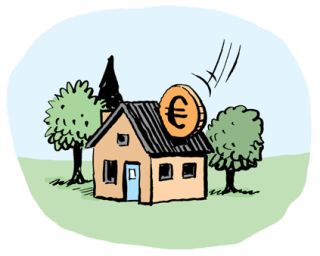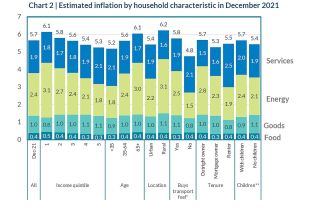Lower income, rural and older households most impacted by rising inflation

The latest Central Bank Economic Letter ‘Household Characteristics, Irish inflation and the cost of Living’ finds that lower income, rural and older households have faced a higher than average increase in the cost of living in recent months. This is because energy-related spending – both home heating/energy and transport – is a higher share of overall expenditure for these households, and higher energy prices are currently the main driver of inflation. Relative to higher income households, a greater share of spending by lower income households is on energy and food, and less on goods and services.
Main Findings
Energy spending, accounts for 14% of disposable income for low income households, compared to 5.5% for high-income households. Large increases in energy prices impact lower income households more as they do not have the capacity to absorb these increases with an increase in income. This lack of capacity to absorb increases energy costs means that different household types have been impacted by the increased rate of inflation in different ways.
The Central Bank Economic letter shows that in December 2021 the headline rate of inflation was 5.7% for the average household. However when this is broken down by household type, the rate of inflation was highest for rural households (6.2%), followed by lower income and older households (6.1%). Larger increases in energy prices are the main drivers of differences between households types. Energy (home energy/heating and personal transport) accounts for half of the estimated inflation rate for rural households (3.1% of the 6.2%) compared to just over 40 per cent (2.2% out of a total of 5.4%) of estimated inflation rate urban households. Non or low driving households have the lowest estimated inflation in December 2021, at 4.8%. These findings are outlined in the chart below.

Policies to support households most impacted
The Central Bank report notes that policies to alleviate recent cost of living increases should focus on the main driver of these increases, namely energy related spending and consumption. Linking supports to existing social transfers, such as recent changes to the winter fuel allowance, or assisting lower-income groups in other ways, will target the groups most affected by recent price increases.
Social Justice Ireland proposed two practical measures to Government to reduce the cost of living for low income households; benchmarking core social welfare rates to 27.5 per cent of average weekly earnings and making the two main tax credits refundable. These policies would directly assist people on fixed incomes and people in low paid employment who are most impacted by the rising cost of living. In our response to the package of measures to deal with the cost of living announced by Government on 10th February, we noted that the bulk of the funding available (€378m) went on a universal energy credit, rather than on measures to target low income and rural households who have been most impacted by increasing energy prices. A more appropriate use of the €378m allocated to the universal energy credit would have been to implement the OECD recommendation to redesign the fuel allowance, delink it from heating fuels, update and expand the eligibility criteria and provide it to eligible households during the whole year. This would provide a tool for Government to target and support rural and low income households (those impacted most by inflation) now and in the years ahead as policies to meet the targets set out in the carbon budgets are implemented.